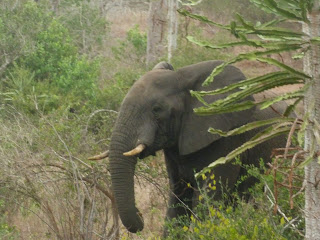 |
| Imbondeiro trees are starting to sprout |
Efforts by the Kissama National Park Association to re-establish the animal population has taken place in the form of the project "Operation Noah's Ark" in which primarily elephants from neighboring Botswana, Namibia and South Africa were either airlifted or shipped to Kissama.
We headed to the park last weekend with friends and stayed in some small cabins inside the park which were just fine. It was a holiday weekend and there were many people there. We had originally scheduled a safari for the afternoon after we arrived, but they were over-booked, so we settled for a nice boat ride on the Kwanza river which was bordered by grasslands and beautiful hyacinths. We saw a small, baby crocodile, but no manatees. I spoke to one of the guards and he said that they had started to see younger generations of animals and that they were pleased that the different animal populations were growing.
 |
| I can live anywhere that has palm trees! |
The vehicles were open and we bounced around and I was slapped and whipped a bit by the overhanging branches since I sat on the side, but it was still really enjoyable. The temperature was perfect, but climbing steadily with the sun. My little camera is just not good enough for the shots I want to take!
As we headed to the river, we heard some trumpeting! Could it be? Yes, a single, young male elephant with small tusks, trumpeting at us through the trees. He was flapping his ears and making lots of noise, being a real show off! He was trying to scare us, but he never got too close. He followed us through the trees and underbrush marking his territory as we observed each other for a good while. After all pictures were taken and everyone had had a good look, we headed to the river. Although my family has seen many elephants in Sri Lanka, for some reason, this encounter seemed more "real" and maybe it was the proximity as well as his behavior that made it thrilling. Down by the river we saw water buffalo and wildebeests and as we returned many more antelope, bush bucks and elands.
There are supposed to be some ostriches and zebras in the park, but in small numbers and we never sighted them. A count conducted in 2008 found 15 ostriches, 55 elephants and 45 zebras. Given the sheer size of the park, we were lucky to see the animals we saw!
For a small taste of what it looks like, please see: http://www.youtube.com/watch?v=v4Xc_psxi9U
For more information; http://www.wild.org/where-we-work/quicama-kissama-national-park-angola/







































